Inactivated Bacteria and Excreted Factors for Colorectal Cancer Treatment
By LabMedica International staff writers
Posted on 22 Nov 2015
Inactivated Clostridium sporogenes bacteria and medium harvested after growth of the bacteria were found to be potent inhibitors of colorectal cancer cells growing on two- and three-dimensional culture platforms.Posted on 22 Nov 2015
Since they rely on oxygen molecules to damage the DNA of cancer cells, traditional cancer treatments such as chemotherapy and radiation therapy have limited efficacy for the treatment of colorectal cancer due to reduced blood flow and the lack of oxygen and nutrient flow in the tumor environment.

Image: Micrograph of the Gram-positive bacillus C. sporogenes (Photo courtesy of the University of Pennsylvania).
While bacterial cancer therapy has the potential to overcome the hypoxia problem, it comes with the risk of toxicity and infection. To circumvent these issues, investigators at Nanyang Technological University (Singapore) studied the antitumor effects of non-viable bacterial derivatives of Clostridium sporogenes, an anaerobic, rod-shaped bacterium that produces oval, subterminal endospores and is commonly found in soil. Unlike C. botulinum, it does not produce the botulinum neurotoxins.
The non-viable derivatives examined in this study were heat-inactivated C. sporogenes bacteria (IB) and secreted bacterial proteins in culture media, known as conditioned media (CM). The effects of IB and CM on CT26 and HCT116 colorectal cancer cells were examined on two-dimensional and three-dimensional platforms.
Results reported in the October 28, 2015, online edition of the journal Scientific Reports revealed that IB significantly inhibited cell proliferation of CT26 cells to 6.3% of the control in 72 hours for the two-dimensional monolayer culture. In the three-dimensional spheroid culture, cell proliferation of HCT116 spheroids notably dropped to 26.2%. Similarly the CM also remarkably reduced the cell-proliferation of the CT26 cells to 2.4% and 20% in the two-dimensional and three-dimensional models, respectively. Interestingly the effect of boiled conditioned media (BCM) on the cells in the three-dimensional model was less inhibitory than that of CM.
"We found that even when the C. sporogenes bacteria is dead, its natural toxicity continues to kill cancer cells, unlike the conventional chemotherapy drugs which need oxygen to work," said senior author Dr. Teoh Swee Hin, professor of chemical and biomedical engineering at Nanyang Technological University. "While other research groups have experimented with bacteria therapy to destroy cancer cells, the biggest problem is that live bacteria will grow and proliferate, posing a high risk of infection and increased toxicity to patients. In the NTU study, as the bacteria were already killed by heat, there was no risk of the bacteria multiplying and causing more harm than the desired dose meant to kill colorectal cancer cells."
The next step will be to isolate specific bacterial components that help to kill tumor cells and to develop them into a usable therapy format.
Related Links:
Nanyang Technological University













